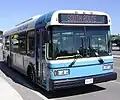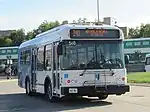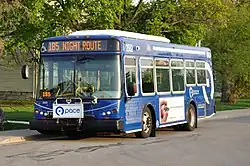| ENC E-Z Rider | |
|---|---|
 Current model, E-Z Rider II BRT operated by Pasadena Transit | |
| Overview | |
| Manufacturer | ENC |
| Production |
|
| Assembly | Riverside, California |
| Body and chassis | |
| Class | Transit bus |
| Body style | Low-floor, mid-sized, heavy-duty bus |
| Layout | Rear-engine, rear-wheel-drive |
| Powertrain | |
| Engine |
|
| Transmission | |
| Dimensions | |
| Wheelbase |
|
| Length |
|
| Width | 102 in (2.59 m) |
| Height |
|
| Curb weight | |
The ENC E-Z Rider and its successor E-Z Rider II are a line of low-floor, mid-sized, heavy-duty transit buses available in 30', 32', and 35' nominal lengths manufactured by ENC (formerly ElDorado National–California) in Riverside, California starting from 1996. In addition to the different lengths, the buses are available with several powertrain options including traditional diesel, CNG, LNG, Propane, and diesel-electric hybrid.
The initial E-Z Rider was offered from 1996 to 2001. ENC marketed its successor, the E-Z Rider II, from 2001 to 2007. From 2005 until 2014 ENC also offered a restyled model as the E-Z Rider II MAX. The most recent and currently sold version is the E-Z Rider II BRT with bus rapid transit styling and features, which was introduced in 2008.
Design
ElDorado National filed an application in 1994 to trademark the name E-Z Rider, and the cited date of first use is June 1996.[4] It was the first low-floor bus from ElDorado, and is deployed typically as a shuttle bus for universities, airport hotels, small transit fleets, and car rental services, but also has been used as a heavy-duty transit bus,[5] as it was designed to the required 12 year/500,000-mile STURAA life. Like most low-floor buses offered in North America, the E-Z Rider and E-Z Rider II have a partial low-floor layout, where the seating area from the rear axle to the back of the bus is on an elevated platform to provide space for the engine and transmission.[6][7]
Updates
The E-Z Rider was offered in a single 30' nominal length, with a wheelbase of 152 in (3.9 m). Several different floorplans were offered to accommodate 20 to 29 seated passengers. Floor height varied from 14 in (360 mm) at the door to 11 in (280 mm) while kneeled.[6][7]
The E-Z Rider II is offered in three different lengths (30', 32', 35' nominal). The wheels of the E-Z Rider II are larger at 22.5 in (570 mm) than those of the E-Z Rider at 19.5 in (500 mm),[6] the floor height at the entry doors has increased slightly to 14+3⁄8 in (370 mm).[8][9] The wheelbase of the E-Z Rider II (and the MAX and BRT variants) has been extended to 160, 168, 220 in (4.1, 4.3, 5.6 m) for the 30', 32', and 35' models, respectively.[8][9][10] The front and rear overhangs of the BRT measure 91.5 and 115 in (2.32 and 2.92 m), respectively.[11][12]
Initial versions of the E-Z Rider II were styled similarly to the E-Z Rider, with quad sealed-beam headlights. Later, the E-Z Rider II was restyled with small round projector headlights; the MAX can be distinguished by the slight upward tilt (at the outer corners) of its headlight array compared to the original II. The BRT uses a front end and windshield that is canted backward for streamlining.
 E-Z Rider (LADOT)
E-Z Rider (LADOT) E-Z Rider II (original, Orillia Transit)
E-Z Rider II (original, Orillia Transit) E-Z Rider II (restyled, York Region Transit)
E-Z Rider II (restyled, York Region Transit) E-Z Rider II MAX (Pace)
E-Z Rider II MAX (Pace) Rear of E-Z Rider II MAX (LADOT)
Rear of E-Z Rider II MAX (LADOT) E-Z Rider II BRT (LADOT DASH)
E-Z Rider II BRT (LADOT DASH)
Hybrid

In the late 1990s, LADOT contracted with ISE Corporation to build eight prototype ThunderVolt series hybrid buses by installing an electric traction motor driven by an auxiliary power unit (APU) and storage battery into E-Z Rider buses. Four of these buses were to be equipped with propane-fueled 30 kW Capstone Turbine APUs and four would use propane-fueled internal combustion engine APUs built by GM. Regardless of the APU type, the electric drivetrain remained the same, a Siemens traction motor and lead-acid battery.[13][14]
The E-Z Rider II also was sold with the ISE ThunderVolt hybrid-electric propulsion, including at least four buses (to Big Blue Bus serving Santa Monica, California) with gasoline-fueled APUs and similar electric traction equipment.[15] Big Blue Bus had originally planned to acquire ten hybrid buses.[16] Over time, the ISE ThunderVolt systems proved to be unreliable and many buses equipped with the system were either retired or repowered.
In more recent years, ENC has started offering the Allison Transmission H 40 hybrid system, which has been proven much more reliable in applications with transit agencies across the nation. The H 40 hybrid system is coupled to the engine in lieu of a conventional transmission and offers continuously variable gear ratios with integrated assistance from a 600 V(AC) electric traction motor that is capable of driving the bus on electricity alone if needed; separate regenerative braking, power conversion, and energy storage modules are included.[17][18] In 2021, the San Francisco Municipal Railway ordered 30 E-Z Rider II BRT coaches equipped with the H 40 hybrid system.[19]
Fuel cell
.jpg.webp)
ThunderPower, LLC, a joint venture of Thor Industries (the parent of ElDorado National at the time) and ISE Corporation (a hybrid drivetrain integrator), designed and built the ThunderPower TB30-FCH fuel cell prototype bus. The TB30-FCH was built on a 30' E-Z Rider II chassis, and equipped with a UTC Power hydrogen fuel cell and the ISE ThunderVolt series hybrid powertrain. The ThunderPower prototype was tested by SunLine Transit Agency in 2002, including three months of revenue service.[20] It was subsequently tested at Chula Vista Transit[21] and AC Transit.[22] With a curb weight of 25,180 lb (11,420 kg), the prototype had a range of 250 mi (400 km).[23]
After the test, the larger ENC Axess was selected as the chassis for further development and commercialization of fuel cell buses as part of the American Fuel Cell Bus (AFCB) program.[24]
Competition
- Gillig Low Floor – Low-floor bus offered in mid-sized lengths
- NABI LFW – Discontinued (1997–2015) low-floor bus offered in mid-sized lengths
- Neoplan Transliner – Discontinued (1981–2006) high-floor and low-floor bus offered in mid-sized lengths
- New Flyer Low Floor – Discontinued (1991–2014) low-floor bus offered in mid-sized lengths
- New Flyer Xcelsior – Low-floor bus offered in mid-sized lengths
- Orion VII – Discontinued (2001–2013) low-floor bus offered in mid-sized lengths
References
- ↑ ElDorado National Model E-Z Rider II, report PTI-BT-R0107 (Report). Bus Testing and Research Center of the Pennsylvania Transportation Institute. October 2001. Retrieved January 27, 2021.
- ↑ ElDorado National Model E-Z Rider II, report PTI-BT-R0209-P (Report). Bus Testing and Research Center of the Pennsylvania Transportation Institute. April 2002. Retrieved January 27, 2021.
- ↑ ElDorado National Model EZ Rider II, report PTI-BT-R0215-P (Report). Bus Testing and Research Center of the Pennsylvania Transportation Institute. June 2002. Retrieved January 27, 2021.
- ↑ "E-Z Rider, application No. 74528388". United States Patent and Trademark Office. Retrieved February 1, 2021.
- ↑ Brophy, Jim (September 26, 2020). "Bus Stop Classics: Transmark RE/Eldorado – If You Rented a Car in the US, You've Probably Rode On This Bus". Curbside Classic. Retrieved February 4, 2020.
- 1 2 3 "E-Z Rider". ElDorado National. Archived from the original on March 5, 2001.
- 1 2 "EZ-Rider". Thor Industries. Archived from the original on February 2, 2003.
- 1 2 "E-Z Rider II (brochure)" (PDF). ElDorado National Online. May 2009. Archived from the original (PDF) on March 26, 2010.
- 1 2 "E-Z Rider II BRT (brochure)" (PDF). ElDorado National Online. September 2008. Archived from the original (PDF) on March 26, 2010.
- ↑ "E-Z Rider II" (PDF). ENC. March 2018. Retrieved December 28, 2021.
- ↑ "32' – Rider II BRT". January 24, 2015. Retrieved May 7, 2021.
- ↑ "EZ Rider II Max – 35'" (PDF). August 1, 2018. Retrieved May 7, 2021.
- ↑ Northeast Advanced Vehicle Consortium; M.J. Bradley & Associates (2000). "3.4.1.1 Project Descriptions: Los Angeles Department of Transportation". Hybrid-Electric Transit Buses: Status, Issues, and Benefits (PDF) (Report). Transportation Research Board. pp. 44–46. ISBN 0-309-06651-4. ISSN 1073-4872. Retrieved May 11, 2021.
- ↑ "Information on ThunderVolt". AltEnergyMag. April 2001. Retrieved December 31, 2021.
- ↑ Wayne, Tony (July 17, 2015). "Conversion of Gasoline Hybrid to CNG on 2010 ElDorado National E-Z Rider buses". City of Santa Monica. Retrieved May 10, 2021.
- ↑ "Santa Monica's Big Blue Bus to Receive Nearly $13 Million in Federal Economic Stimulus Funds; Plans to Infuse Money Back into Economy with New Contracts" (PDF) (Press release). City of Santa Monica. March 25, 2009. Archived from the original (PDF) on May 3, 2012.
- ↑ "Allison Hybrid H 40 EP / H 50 EP" (PDF). Allison Transmission. November 2011. Retrieved December 29, 2021.
- ↑ "Allison Hybrids Deliver Advanced Technology And Proven Reliability" (PDF). Allison Transmission. December 2016. Retrieved December 29, 2021.
- ↑ "Allison Transmission and ElDorado National Partner to Bring Electric Hybrid Buses to San Francisco" (Press release). Allison Transmission. August 26, 2021. Retrieved December 29, 2021.
- ↑ Chandler, Kevin; Eudy, Leslie (November 2003). Fuel Cell Transit Buses: ThunderPower Bus Evaluation at SunLine Transit Agency (PDF) (Report). National Renewable Energy Laboratory.
- ↑ "SunLine Test Drives Hydrogen Bus" (PDF). United States Department of Energy. August 2003. Retrieved February 1, 2021.
- ↑ "4285". Alameda-Contra Costa County Transit. Retrieved May 7, 2021.
- ↑ "Hydrogen Workshop for Fleet Operators" (PDF). The National Hydrogen Association. Retrieved December 29, 2021.
- ↑ "American Fuel Cell Bus Project" (PDF). National Renewable Energy Laboratory. February 2012. Retrieved February 1, 2021.